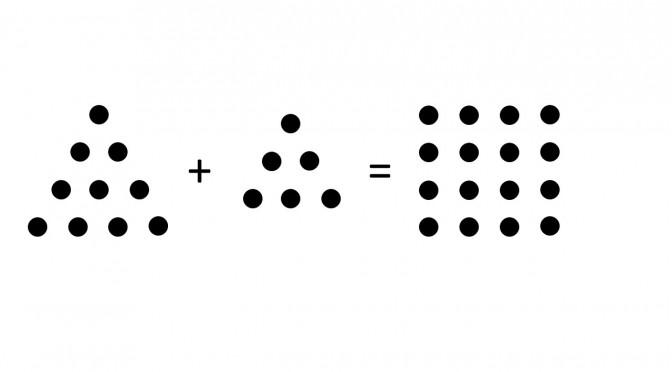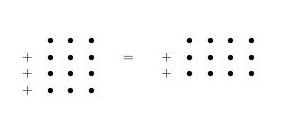Why even ask a question like that? Everyone knows that ![]() , just like everyone knows that
, just like everyone knows that ![]() . Mathematicians would say that multiplication or addition of two numbers is commutative, meaning that you get the same answer regardless of the order in which you do the multiplication or addition. But what does that really mean? When we say
. Mathematicians would say that multiplication or addition of two numbers is commutative, meaning that you get the same answer regardless of the order in which you do the multiplication or addition. But what does that really mean? When we say ![]() , we literally mean “3, 4 times,” or 4 sets of 3 objects each, or
, we literally mean “3, 4 times,” or 4 sets of 3 objects each, or ![]() objects. Likewise, when we say
objects. Likewise, when we say ![]() , we mean “4, 3 times,” or 3 sets of 4 objects each, or
, we mean “4, 3 times,” or 3 sets of 4 objects each, or ![]() objects. Most people would think it’s obvious that
objects. Most people would think it’s obvious that ![]() , but it’s equivalent to saying that
, but it’s equivalent to saying that ![]() , which seems quite a bit less obvious. So how do we know it? Is the fact that multiplication is commutative just something we assume about numbers, or is there a way to prove it?
, which seems quite a bit less obvious. So how do we know it? Is the fact that multiplication is commutative just something we assume about numbers, or is there a way to prove it?
A Simpler Look at Numbers
Pretend for a minute that you live in a society that doesn’t have symbols dedicated to numbers. If you needed to do some figuring, you might use dots or marks to indicate units. So the number 3 would look like:
![]()
And the formula ![]() would look like:
would look like:
![]()
From this vantage point, the commutative property of addition seems almost trivial: ![]() becomes:
becomes:
![]()
It’s immediately obvious why this would be the case. If the dots were rocks, you could take the group of four rocks and place it either in front of or behind the group of three rocks to give the same number of rocks. It makes no difference where the rocks are in relation to each other. Likewise, it makes no difference whether the 3 or the 4 comes first in the sum ![]() . You’re gonna get seven no matter what.
. You’re gonna get seven no matter what.
But now let’s go back to the original problem concerning the commutative property of multiplication. If we remember from before, we had ![]() . In our new number system, that’s:
. In our new number system, that’s:
![]()
We can write this much more suggestively:
Written this way, it’s a lot easier to see how ![]() could be true. It’s clear that
could be true. It’s clear that ![]() makes a rectangle 3 dots wide and 4 dots high, while
makes a rectangle 3 dots wide and 4 dots high, while ![]() is simply the same rectangle rotated by 90 degrees:
is simply the same rectangle rotated by 90 degrees:
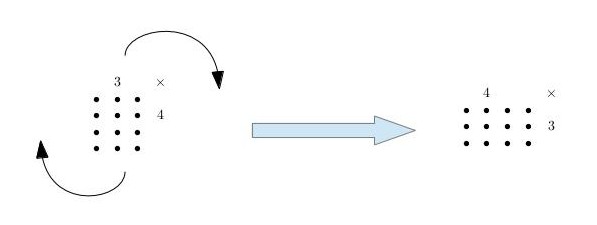 It’s also pretty clear that no matter what numbers
It’s also pretty clear that no matter what numbers ![]() and
and ![]() you choose, you can always construct an
you choose, you can always construct an ![]() rectangle that can be rotated by 90 degrees to give you
rectangle that can be rotated by 90 degrees to give you ![]() . In fact, you can use this type of visualization technique to come up with all sorts of other mathematical insights. I’ll mention two briefly.
. In fact, you can use this type of visualization technique to come up with all sorts of other mathematical insights. I’ll mention two briefly.
Extending the Visual Method
Let’s tackle an easy one first: the distributive property. For those of you who don’t remember the lingo, the distributive property refers to the equality:
![]()
The easiest way to visualize this is to use concrete numbers, so let’s let ![]() ,
, ![]() , and
, and ![]() . This will give us
. This will give us ![]() I’m using small numbers to make it less tedious for me to draw dots, but feel free to draw as many dots as you like to prove these ideas to yourself. So let’s get to drawing.
I’m using small numbers to make it less tedious for me to draw dots, but feel free to draw as many dots as you like to prove these ideas to yourself. So let’s get to drawing. ![]() is going to be equivalent to
is going to be equivalent to ![]() :
:

Similarly, the right side, ![]() , will look like this:
, will look like this:

It’s pretty obvious here that all we’ve done is divide the big ![]() rectangle representing the left side into two smaller
rectangle representing the left side into two smaller ![]() and
and ![]() rectangles representing the right side:
rectangles representing the right side:

Okay, so that one was really easy. But I promise, we can use these stupid dots to prove something more interesting. Here’s another example.
Arithmetic meets Geometry
It should be abundantly clear using this method why, for example, ![]() is called 4 “squared:”
is called 4 “squared:”
![Rendered by QuickLaTeX.com \[ \begin{matrix} \bullet&\bullet&\bullet&\bullet\\ \bullet&\bullet&\bullet&\bullet\\ \bullet&\bullet&\bullet&\bullet\\ \bullet&\bullet&\bullet&\bullet \end{matrix} \]](https://www.howdoweknowit.com/wp-content/ql-cache/quicklatex.com-5417e33a29a67bd13a2f335e73e10ee6_l3.png)
But there are other shapes you can make. For instance, if you take ![]() , you can make the following shape:
, you can make the following shape:
![Rendered by QuickLaTeX.com \[ \begin{matrix} \bullet&~&~\\ \bullet&\bullet&~\\ \bullet&\bullet&\bullet \end{matrix} \]](https://www.howdoweknowit.com/wp-content/ql-cache/quicklatex.com-ed78a8942b01d7b8edfdfc3ee9558731_l3.png)
This is why 6 is known as a triangular number. In fact, any number that’s the result of a sum like ![]() is a triangular number. The first triangular number is 1, or
is a triangular number. The first triangular number is 1, or ![]() , the second is
, the second is ![]() , the third is
, the third is ![]() , and so on. Now look what happens when we cut a square number like
, and so on. Now look what happens when we cut a square number like ![]() along a diagonal:
along a diagonal:
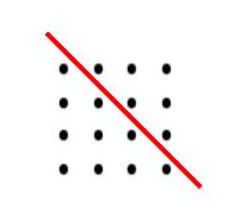 We see that
We see that ![]() is just equal to the sum of two triangular numbers:
is just equal to the sum of two triangular numbers: ![]() and
and ![]() . In fact, if we concentrate (or maybe pull out a pen and paper), we can see that a square number will always equal two triangular numbers in this fashion, giving us a general formula connecting square numbers and triangular numbers:
. In fact, if we concentrate (or maybe pull out a pen and paper), we can see that a square number will always equal two triangular numbers in this fashion, giving us a general formula connecting square numbers and triangular numbers:
![]()
a result that’s a little more interesting than the commutative and distributive properties. There are actually plenty of other formulas like this one that you can derive by using these dumb little dots. You can start looking at polygons with more sides: they give you pentagonal numbers, hexagonal numbers, and so forth. You can even generalize to higher dimensions. Cubic numbers like ![]() might already be familiar:
might already be familiar:
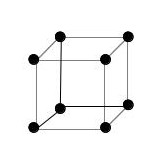 but what about pyramidal numbers or numbers that group together to make a dodecahedron? I can tell you right now from the picture above, it looks like you could probably cut up a cubic number into pyramidal numbers, the same way we cut up a square number into triangular numbers earlier. Who knows what other crazy insights we could come up with? And all because we asked the question, “How do we know that
but what about pyramidal numbers or numbers that group together to make a dodecahedron? I can tell you right now from the picture above, it looks like you could probably cut up a cubic number into pyramidal numbers, the same way we cut up a square number into triangular numbers earlier. Who knows what other crazy insights we could come up with? And all because we asked the question, “How do we know that ![]() ?”
?”
